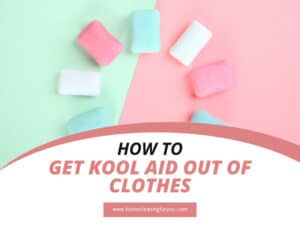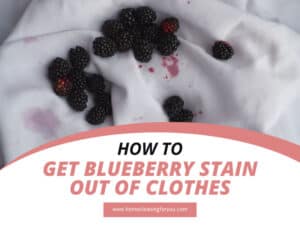Ideal Ways to Remove Stubborn Coconut Oil from Clothes

Knowing how to get coconut oil out of clothes may be one of the most interesting life hacks you wish you could learn sooner! Coconut oil is a multi-purpose oil used in many different contexts such as cooking or hair care. But it may leave an annoying stain on your clothes!
I have to admit that stains from oil are super hard to remove since the oil is water-insoluble so you cannot get rid of it just by washing your item with water. So, what can you do? Follow me and learn some great tricks to fix this problem in no time!
What Is Coconut Oil And Does It Stain?
Coconut oil is an edible processed form of coconut palm fruit’s meat, milk, and wick. It consists of saturated fats that can melt at room temperature (about 78oF). (1) And the high-fat content is one of the main reasons coconut oil can stain on most fabric types.
The fats in coconut oil can leave dark-colored stains on your clothes after a while. The coconut oil stains are really difficult to remove without proper methods and detergents. With stains that have been set, it may take you a lot of time to eliminate.
Coconut oil has tons of uses and health benefits. Besides the use in cooking, people tend to use coconut oil as a cosmetic to boost the health of their skin, which adds moisture to dry skin. (2) It may also help you get smooth and shiny hair if you use it persistently.
When you use coconut oil in cooking or as a treatment in haircare or skincare, you may, unfortunately, get some drops of them on your clothes. Without noticing, the coconut oil on your clothes will become ugly stains if you don’t treat them soon.
So, how can you deal with coconut oil spilled on your garments? Before throwing them away, consider applying my suggestions to see if they can help!
Treat your frizzy hair with some coconut oil and be amazed after a few days!
Specific Methods To Remove Fresh Coconut Oil Stains
If you have just accidentally dropped some coconut oil on your T-shirt while applying it to your hair, don’t freak out and follow these methods below! You can say bye-bye to the fresh oil stain in just a minute!
Liquid Dishwashing Detergent
It is very simple to use only one detergent to treat fresh coconut oil stains. Just with liquid dish detergent, you can remove the oil before it sets a stain. The quicker you deal with it, the higher the chance of successfully removing it will be.
Keep in mind that it’s highly recommended to use natural dish soap rather than the types made of chemicals, so that no toxic substances can get onto your clothes.

Preparation:
- Dishwashing detergent
- A soft brush (optional)
- Washing machine
Step 1: Apply The Liquid Dish Soap
Pour some drops of dishwashing detergent into the stained spots on your clothes. Rub it with a soft brush or your fingers in circular motions. Another way to do it is fold your clothing and rub the folds against each other.
Leave it on the clothes for 15 to 30 minutes to absorb into the fibers.
Step 2: Wash And Dry Your Clothing
Check the care label to identify the highest water temperature that the garments can withstand. Set the washing machine at the hottest temperature based on your clothes’ conditions and run a normal wash cycle. Dry them as you wish.
Note: If you can, just don’t use cold water. Hot water will break the oil so that it may disappear easier.
Baking Soda And Liquid Detergent
Power-based or liquid detergents are all strong detergents, even when you use them alone. Baking soda is usually used in this method, but you can always replace it with cornstarch or arrowroot powder.

Preparation:
- A white soft towel/ Paper towels
- Baking soda/ cornstarch/ arrowroot powder
- An old soft-bristled toothbrush
- A liquid detergent (dish soap/ liquid laundry detergent)
Step 1: Blot The Excess Oil
Take the white towel or paper towel and dab it onto the stained area to blot away the excess coconut oil. Slowly and gently press the towel against the clothes, don’t make it too hard; otherwise, the remaining oil will absorb more to the fabric.
Continue this step until almost all spilled oil is blotted.
Warning: Only use the kitchen towel in plain white, not in any other color, since the coconut oil will transfer the dye color to the affected clothes and make it worse! If you don’t have a white towel, just use a paper towel to blot.
Step 2: Apply Baking Soda
Sprinkle some powdered detergent onto the stain until the whole stained area is fully covered. Baking soda, cornstarch, or arrowroot powder are all fine. Just use the powder available in your house at the time.
Use the old soft-bristled toothbrush or your fingers for better rubbing the baking soda on the fabric. Allow the powder to soak up the oil. Observe the powder, then you will see that it will start to change the color from white to light brown.
If the powder changes the color too fast, you should sprinkle more powder onto the stain, since it proves that there is still a lot of excess oil on the fabric. Continue to add more powder until the color change slows down.
For the large stains, this process may last from 30 to 60 minutes; while with smaller stains, it only lasts for about 10 to 15 minutes.
Step 3: Scrape The Clumps Off
Use a blunt utensil such as a metal spoon and butter knife, even an old credit card to scrape away the clumps created from baking soda. Put some pressure on the utensil and drag it across the stain to get the clumps off.
Repeat this step until the powder clumps have been removed completely.
Step 4: Wash And Dry
Rub a small drop of liquid detergent onto the stained spot. Then put the whole garment into the washing machine to wash with the highest temperature setting that your clothing can endure.
Air dry your clothes after washing. Avoid using dryers since the heat from them may set the unluckily-remained coconut oil stains permanently.
Using baking soda to soak up the coconut oil stains is a quick and smart way!
A Thorough Way To Rid Of Dried Coconut Oil Stain On Clothing
You may not realize that the coconut oil stains have already been there on your clothing for a few days, even after washing. The dried coconut oil stains may look clear and blotchy with light brown color. If you happen to see them, treat them with this method immediately!
WD-40, Powdered Detergent, And Dish Soap
It’s quite obvious that old stains are a little bit harder to remove than fresh ones. The oil clings to your clothes for a while and doesn’t fade away after some basic wash with laundry detergent. Therefore, you have to treat it with a specialized product: WD-40.

Preparation:
- WD-40
- Baking soda/ Cornstarch
- Dishwashing detergent
- A piece of cardboard
- A soft-bristled toothbrush
Step 1: Place The Cardboard
Put the piece of cardboard under the stained area on your clothes. This can prevent the stains from getting on other surfaces.
Step 2: Apply WD-40
Spray WD-40 directly to the stained spot. By doing this, you are reactivating the greasy residue in the oil stains and loosening the oil particles gradually. The WD-40 spray will seep through the fiber and soak in the cardboard piece. You can lift it up to observe.
Step 3: Lift The Stain With Powdered Detergent
Apply baking soda or cornstarch on the sprayed areas. Then, use the soft-bristled toothbrush to rub the powder on the stains. It will activate the oil again and slowly create clumps when mixed with WD-40.
Repeat this step over again and apply to other stained areas treated with WD-40 to make the clumps larger. After that, shake off the garment hard to remove the excess clumps. Check the stain to see whether you have to continue the process.
Keep repeating until the clumping becomes smaller than before. Yup, this step may take you a lot of patience and time to complete. When the powder doesn’t create clumps anymore, it means that all WD-40 has been eliminated and you can stop.
Step 4: Toss The Cardboard Away
At this point, you can discard the piece of cardboard. Remember to clean up the powder clumps, too.
Step 5: Apply Dishwashing Detergent
Rub a drop of liquid dish soap on each stain with a clean toothbrush. Leave them there for approximately 15 minutes.
Step 6: Wash And Dry The Treated Clothes
Set the washing machine to the highest water level that your laundry can withstand. Don’t forget to check their care labels first!
Line dry the washed clothes in the fresh air and sunlight.
Note:
- Don’t use the dryer to dry your clothes because the remaining stains can set forever on your garments.
- This method can be best to apply for white or light-colored clothes.
Oxygen Bleach
If you can’t find WD-40 around your place, oxygen bleach like OxiClean is also a great option. Although it is a kind of bleach, it is safe to use for both colored and white clothes, so don’t worry if the stain stays on your favorite colored T-shirt.

Preparation:
- Oxygen bleach
- Hot water
- Paper towel
- A container (washtub, bucket, etc.)
- Regular laundry detergent
Step 1: Blot The Stain
Blot the oil stain with a paper towel as much as possible.
Step 2: Make The Bleach Solution
Prepare the solution with oxygen bleach following the directions on the package; or you can mix 6 ounces of oxygen bleach powder and 1 gallon of hot water. Stir it well.
Step 3: Soak The Clothes In Solution
Then, submerge all your clothes into the solution. Don’t worry; it won’t discolor your garment. Let them stay like that for about 2 hours.
Step 4: Wash And Dry The Laundry
Now it’s time to bring your soaked clothing items to the washing machine and run a wash cycle with regular laundry detergent as you would usually do.
But remember to check the care label and set the washing machine at the hottest water settings that your clothes can withstand. Keep in mind that the water temperature is really important here!
Step 5: Rub The Stain And Air Dry The Clothes
After the wash, rub the stained spots potently to get rid of any excess stain.
Dry them under sunshine and fresh air in an airy place. A dryer, in this case, is a no-no! Avoid using a machine dryer if you don’t want your clothes to get permanent stains.
OxiClean is a common and useful oxygen bleach to use in removing different types of stain!
Bonus Information: You can substitute oxygen bleach with a spot remover for oil stains. You will get the same result as using oxygen bleach to remove the old coconut oil stains.
Learn To Treat Coconut Oil Stains On Different Fabric Types
With each kind of fabric, there will be a different detergent or method to deal with it. So if you want to know how to treat each fabric type, check this section right away!
Cotton Fabric
Cotton is one of the most typical types of fabric that can be used to make most T-shirts. You should deal with the coconut oil stains on cotton as quickly as possible because this fabric absorbs the oil very fast and can set a stain in no time.

White And Light-Colored Cotton Items
With light-colored clothing, you may want to use dish soap and baking soda to get rid of the stubborn oil stains.
Preparation:
- Dishwashing detergent
- Baking soda
- A blunt item (metal spoon, butter knife, etc)
Instructions:
Step 1: Place a thick layer of baking soda on the stain. Allow it to absorb the oil in 15 minutes, then scrape the powder off with a blunt item.
Step 2: Wash the garment with the hottest water setting that your clothing can endure.
Step 3: Take the clothing out after a wash and pour some drops of the dishwashing detergent onto the stained area. Then, leave it there for about 15-30 minutes.
Step 4: Rewash the items with laundry detergent and hot water. Dry the clothes as you wish.
Dark, Black, And Vibrant-Colored Cotton Items
To treat the dark- or vibrant-colored cotton clothes, you can use the earlier method for white clothes. However, replace baking soda with cornstarch, since it is safe to use for colored clothes.
You should also use cold water, not hot water to wash these garments in dark color.
Denim Fabric
With denim fabric, or most well-known as jeans, you can break the oil particles apart by using dishwashing detergent and baking soda. It may be easier than you thought, so follow my instructions!

Preparation:
- Dishwashing detergent
- Baking soda/ Cornstarch
- An old, clean toothbrush
- A soft rag or cloth
Instructions:
Step 1: Put the baking soda or cornstarch directly onto the stain. Let it sit for 10-15 minutes to absorb the excess coconut oil.
Step 2: Brush the powder with the old toothbrush. Then bring your jeans to wash with the hottest water they can withstand.
Step 3: Take the jeans out and rub some drops of dishwashing detergent with a soft rag or cloth. Allow the liquid to stay for about 15 minutes.
Step 4: Run another wash cycle for the jeans. Air dry them as you usually do.
Polyester Fabric
Polyester fabric is delicate and absorbent. It absorbs the oil in general and coconut oil specifically really fast. Therefore, it is likely to have a higher chance of getting oil stains on. You can also use baking soda, but hot water is not recommended in this case!

Preparation:
- Baking soda
- Dish soap
- A dull utensil
Instructions:
Step 1: Place the polyester item on a flat surface, then sprinkle the baking soda onto the stained area. Allow the powder to stay for 15 minutes then scrape it off using the dull utensil.
Bonus Information: With further fabric types than polyester, you may have to rub harder or add a thicker layer of baking soda to the coconut oil stains.
Step 2: Wash the clothes with cold water. Remember to use cold water (< 40 degrees) at this step, because the water temperature does matter with polyester fabric.
Step 3: Rub some dish soap on the stained spot, leave it there for a while.
Step 4: Wash your items again. If the stain is still there after the wash, don’t dry your clothes! Instead, repeat the whole process from the beginning.
Since you use cold water, this may take a little bit more time and patience than dealing with other fabrics. But don’t be frustrated, I’m sure that you will succeed after a few attempts!
More Delicate Fabrics
There are even more delicate fabrics than polyester! Silk and satin are some of the most typical examples. You can’t even treat them with baking soda, and hot water is definitely out!

Option 1: Using Baby Powder
Baby powder is safe for baby’s skin; therefore, it can be applied to more delicate fabrics than polyester.
Preparation:
- Unscented baby powder
- Dishwashing soap
- Cold water
- A blunt item (spoon, dull knife, credit card, etc.)
- The softest toothbrush you can find
Instructions:
Step 1: Put some unscented baby powder on the stained spot of the delicate fabric. Let the baby powder sit for at least 1 hour.
Step 2: Gently rub it with your fingers or the softest-bristled in your house. Don’t put too much pressure on the fabric.
Step 3: Pour some drops of dish soap onto the stain and bring the clothes to wash as normal. Always air dry the garments to get the best result. Never use a dryer, especially with these delicate fabric types.
Option 2: Using Dishwashing Detergent And Cornstarch
If the coconut oil stains on delicate fabrics are small or insignificant, and your clothes are washable, then you may not need to bring them to the professional cleaners. Instead, try this treatment option with dish soap and some cornstarch.

Preparation:
- Dish soap
- Cornstarch
- A container (a tub, a sink, etc.)
- A large towel
Instructions:
Step 1: Sprinkle some cornstarch onto the oil stain. Rub the stain for 5 to 10 minutes.
You may need to repeat this step if the stain is a bit severe and it has stayed on the fabric longer than 1 hour.
Step 2: Soak the clothing item in cold water in a tub or a sink. Pour 4-5 drops of dishwashing detergent in and use your hands to stir the mixture until it produces some suds.
Step 3: Rub the item gently with your hands. Focus on the portion where the oil stain stays. Don’t wring the clothes! Keep in mind that they are delicate fabrics that can be damaged when you wring or twist them hard.
Step 4: Wait for about 2-5 minutes. Then, drain the soapy water residue from the container. Fill it once again with cool water, continue to submerge the garments to rinse away the soap.
Repeat this step 2-3 times to ensure that there’s no soap residue left.
Step 5: Cover the clothing item with a large towel, then roll them together just like you’re doing a spring roll.
Press the towel gently to get rid of the excess water from the washed item. Make sure that you don’t stretch or squeeze it out during the whole procedure.
FAQs
Is all of the above information enough for you? If it has not satisfied you, then come through this Q&A section and see whether your concerns are included here or not. But I will always welcome more questions from you!
su_spoiler title=”In what ways can I get the coconut oil out of the carpet?” open=”no” style=”default” icon=”plus” anchor=”” class=””]
Combine two cups of warm water, one tablespoon white vinegar, and one tablespoon of dish soap in a mixing bowl. Use a sponge to dab this mixture into the stains. Allow drying after a basic wash with cold water.
[/su_spoiler]Time To Repel The Pesky Coconut Oil Stains On Your Clothing!
How do you feel about all of the above methods for removing many different kinds of coconut oil stains? Now it’s time to treat your fresh stains from 5 minutes ago or take out and check your old garments to see if any item has brown stains on and treat them.
If this article has helped you somehow, why don’t you hit the like and share button to spread the word to other people? Subscribe to the newsletter to update the latest life hacks and exciting tips in cleaning! And don’t forget to comment below if you have any concerns!
Hope to see you soon in the following articles!

References
- En.wikipedia.org. 2021. Coconut oil – Wikipedia.
- Healthline. 2021. Top 10 Evidence-Based Health Benefits of Coconut Oil.







Samantha Lee
Head Cleaning Expert
Expertise
Professional Home Cleaning, Green Cleaning Techniques, Stain Removal & Fabric Care, DIY Home Maintenance & Organization, Sustainable Cleaning Products, Home Care for Busy Lifestyles
Education
University of Denver
Samantha Lee is the Head Cleaning Expert at HomeCleaningForYou.com, specializing in eco-friendly home care. She holds a Bachelor of Science in Environmental Science from the University of Denver, focusing on sustainable cleaning solutions.
With expertise in green cleaning, stain removal, and DIY home maintenance, she helps homeowners keep their spaces fresh and chemical-free. Samantha has been featured in lifestyle publications and has partnered with brands promoting natural cleaning products.
She also shares practical tips through her blog, online courses, and workshops. Passionate about sustainability, she enjoys testing new eco-friendly cleaning methods and spending time outdoors.